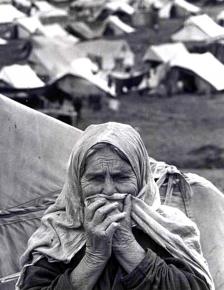The catastrophe that lives on
Irish socialist recalls the use of terror to drive hundreds of thousands of Palestinians from their land in 1948--and the violence that continues to this day.
THE BIRTH of Israel on May 14 in 1948 was a catastrophe for the Palestinians. By the end of the year, around 750,000 women, men and children had been driven from their homes to make space for Jews, most of them refugees fleeing persecution in Europe.
Terrified, bedraggled and penniless, the new refugees fled to camps in Lebanon, Jordan, Syria, the Gaza Strip and the West Bank.
The United Nations General Assembly, having sanctioned the establishment of the new state, passed a resolution demanding that the Palestinian refugees be allowed to return home. Israel refused, setting a pattern of rejection of UN resolutions, which has persisted ever since.
The Palestinian refugees are still waiting. Last summer, in the Bedawi camp in northern Lebanon, packed, teeming, a mind-blowing hubbub of humanity, I talked to an old man who showed me a cracked photograph of the neat, white home in Haifa that he and his parents had been driven from at gunpoint.
Searching for words that might be half-adequate, I mumbled a hope that we might meet soon in a liberated Palestinian capital. "Next year in Jerusalem..." He gestured towards a clump of children laughing and scrambling in the dust. "Perhaps our grandchildren..."

The ethnic cleansing had begun in 1947. David Ben-Gurion, who was to become Israel's first prime minister, explained that the Jewish community could not stand on ceremony in carving out living space: it faced "a second Holocaust."
There was a pattern established in that statement, too. By the end of January 1948, 1,500 Palestinians were dead and 400 Jews. Neither figure amounted to a Holocaust. But the balance in the casualty figures was clear.
The same death-toll disparity has been evident in every clash since, with this difference--that it has expanded grotesquely over the years, as Israeli superiority in weaponry, mainly supplied by the United States, has steadily grown.
THE ETHNIC cleansing of Palestine was carried out in accordance with Plan Dalet:
These operations can be carried out in the following manner: either by destroying villages (by setting fire to them, by blowing them up and by planting mines in their rubble), and especially those population centers which are difficult to control permanently; or by mounting search-and-control operations according to the following guidelines; encirclement of the villages, conducting a search inside them. In case of resistance, the armed forces must be wiped out and the population expelled outside the borders of the state.
The Plan Dalet document was unearthed and published three years ago by the Israeli historian Ilan Pappe in his meticulous, essential, devastating book The Ethnic Cleansing of Palestine.
On April 10, 1948, around 90 villagers in the village of Deir Yassin, including many small children, were massacred. Scores of villagers were summarily shot in Ayn al-Zayton. And so on and on. Plan Dalet was explicit about the purpose: to so terrify the surrounding population that they would flee without waiting for murder to engulf them.
Only racism, the notion that their victims had no entitlement to treatment as human beings, can explain the calmness with which Plan Dalet was executed. Israel was built on racism.
The same attitude was evident in the explanation given by then Prime Minister Ehud Barak in the New York Review of Books in 2001 for the difficulty in finding agreement with the Palestinians: "They are products of a culture in which to tell a lie creates no dissonance...They don't suffer from the problem of telling lies that exists in Judeo-Christian culture."
The UN's original idea had been that Israeli and Palestinian States would exist alongside one another. The plan was hardly fair. At the time, around 6 percent of the territory of Palestine was owned by Jews. But the UN allocated 56 percent to the imminent Jewish State, against 42 percent to Palestinians. An "internationalized" Jerusalem (that didn't last long either) made up the other 2 percent.
Since then, Israel has remorselessly expanded its territory and systematically prevented the emergence of a viable Palestinian state, even on the narrowing patches of land left to the people.
Last month, Israeli Prime Minister Benjamin Netanyahu told U.S. envoy George Mitchell that there'd be no talks about Palestinian statehood until the Palestinians "recognize Israel as 'the State of the Jewish People.'" This was both contemptuous and contemptible.
States recognize states, not the defining ideology or the character of the regime. Netanyahu, observed the Israeli writer Uri Avnery, of course understands this well. The demand was not seriously intended, but was "a tactic for preventing peace." If he is compelled to drop it, it will not be long before he comes up with another.
Israel's rulers have been devising tactics to prevent peace since May 1948. Avnery was then a member of the fearsome paramilitary group, the Irgun. His family had fled to Palestine from Germany in 1933, the year the Nazis came to power. He served three terms in the Knesset before turning to journalism and peace activism.
In 1993, he founded Gush Shalom (the Peace Bloc). He has long given up on the "two state" solution and argues now for a single secular state in historical Palestine in which all the present inhabitants of the territory and the Palestinian diaspora can live as equals.
Avnery is 85, still an indefatigable activist for justice for the Palestinians, a symbol of hope for the future, if there is one.
First published in the Belfast Telegraph.


